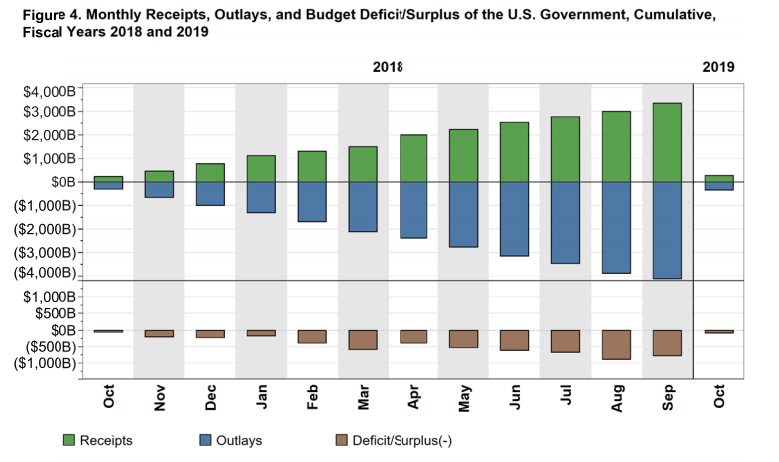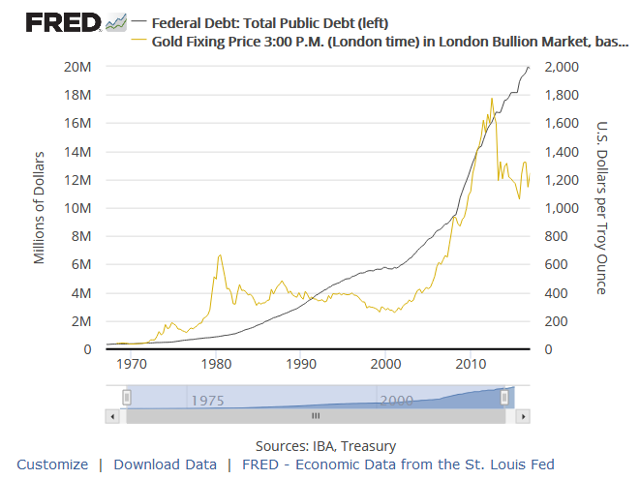US Government Posts Another Big Deficit in October
The federal government ended up fiscal 2018 with the largest budget deficit since 2012. Based on the most recent US Treasury Department projections, that doesn’t look to slow down in fiscal 2019.
Spending didn’t taper off any in October. According to the Treasury Department report, the deficit came in at $100.5 billion last month. That represents a 58% increase from the $63 billion deficit recorded in October 2017. Spending rose 18% year-on-year. Revenues only increased by 7%.

Uncle Sam ended 2018 $779 billion in the red, adding to the ballooning national debt. The CBO projects this year’s deficit will come in close to $1 trillion. The current Treasury Department estimate shows a total fiscal 2019 deficit over the $1 trillion mark at $1.085.
The national debt expanded by more than $1 trillion in fiscal 2018. It currently stands at over $21.7 trillion. According to data released by the Treasury Department, fiscal 2018 gave us the sixth-largest fiscal-year debt increase in the history of the United States. (If you’re wondering how the debt can grow by a larger number than the annual deficit, economist Mark Brandly explains here.)
Although the economy is supposedly in the midst of a boom, US government borrowing looks more like we’re in the midst of a deep recession. Long-term US debt sales have risen to a level not seen since the height of the financial crisis. In October alone, the US Treasury sold over $80 billion in public debt. The government spent $32 billion simply paying the interest on outstanding debt. That was roughly a 30% increase from a year ago.
Annual interest payments already approach $500 billion. Every uptick in the interest rate increases that number. At the current trajectory, the cost of paying the annual interest on the US debt will equal the annual cost of Social Security within 30 years.
This is not good news for the US economy. As we have reported repeatedly, large levels of debt retard economic growth. This explains why despite what is supposed to be a booming economy, revenues to the US Treasury are only up 7% year-on-year. Most of that increase came from tariffs and excise taxes. Corporate and individual tax receipts are up around 1%.
Several studies have estimated that economic growth slows by about 30% when the debt to GDP ratio rises about 90%. Most analysts say the US economy is already in the 105% range.
While this is bad news for the average Amercian, there is a silver lining if you own gold. (Or perhaps we should call it a golden lining.) As Michael Fitzsimmons pointed out in an article published at Seeking Alpha, there is a correlation between rising US debt and the price of gold.

The last time the US government ran a $1 trillion per year annual deficit, gold ended up at $1,800-plus. The yellow metal was in the $1,700 range in 2011 and 2012. As the government ran $1 trillion-plus deficits, gold ran up to nearly $1,900 per ounce.
But that was after digging out of the ‘Great Recession.’ Now, and despite the great economy, what some would generously describe as ‘unwise’ tax-and-spend policies, the US is back on track for a $1 trillion annual deficit for fiscal 2019. Yet gold is barely over $1,200/oz. As a result, there’s currently a massive gap in the relationship between US federal deficits and the price of gold. Clearly, gold has ~50% upside if the relationship between US monthly deficits and the price of gold matches its recent history.”
Get Peter Schiff’s most important Gold headlines once per week – click here – for a free subscription to his exclusive weekly email updates.
Interested in learning how to buy gold and buy silver?
Call 1-888-GOLD-160 and speak with a Precious Metals Specialist today!





 Since Nayib Bukele became president of El Salvador, El Salvador has been in American media and global political discussion more than ever. While much of the attention focuses on Bukele’s mass incarceration of gang members and a decline in homicide of over 70%, Bukele has also drawn attention to his favoritism towards Bitcoin and how he […]
Since Nayib Bukele became president of El Salvador, El Salvador has been in American media and global political discussion more than ever. While much of the attention focuses on Bukele’s mass incarceration of gang members and a decline in homicide of over 70%, Bukele has also drawn attention to his favoritism towards Bitcoin and how he […] With gold hitting yet another awe-inspiring all-time high in the wake of Powell’s remarks reassuring markets (more or less) to expect rate cuts in 2024, a few analysts are pointing out risk factors for a correction — so is there really still room to run?
With gold hitting yet another awe-inspiring all-time high in the wake of Powell’s remarks reassuring markets (more or less) to expect rate cuts in 2024, a few analysts are pointing out risk factors for a correction — so is there really still room to run? Gold hit a new all-time nominal high, surpassing the previous record set in December of the previous year. The precious metal’s price reached approximately $2,140, indicating a robust and continuing interest in gold as a safe-haven asset, despite a rather peculiar lack of fanfare from the media and retail investors. This latest peak in gold […]
Gold hit a new all-time nominal high, surpassing the previous record set in December of the previous year. The precious metal’s price reached approximately $2,140, indicating a robust and continuing interest in gold as a safe-haven asset, despite a rather peculiar lack of fanfare from the media and retail investors. This latest peak in gold […] The gold price has been surging, with unprecedented central bank demand gobbling up supply. It has been a force to behold — especially as US monetary policy has been relatively tight since 2022, and 10-year Treasury yields have rocketed up, which generally puts firm downward pressure on gold against USD.
The gold price has been surging, with unprecedented central bank demand gobbling up supply. It has been a force to behold — especially as US monetary policy has been relatively tight since 2022, and 10-year Treasury yields have rocketed up, which generally puts firm downward pressure on gold against USD.  Total gold demand hit an all-time high in 2023, according to a recent report released by the World Gold Council. Last week, the World Gold Council (WGC) released its Gold Demand Trends report, which tracks developments in the demand for and use of gold around the world. Excluding over-the-counter (OTC) trade, 2023 gold demand fell slightly from 2022 […]
Total gold demand hit an all-time high in 2023, according to a recent report released by the World Gold Council. Last week, the World Gold Council (WGC) released its Gold Demand Trends report, which tracks developments in the demand for and use of gold around the world. Excluding over-the-counter (OTC) trade, 2023 gold demand fell slightly from 2022 […]